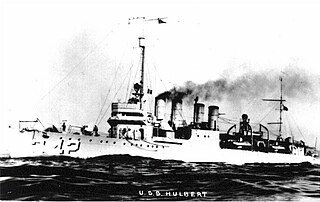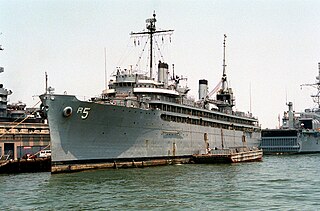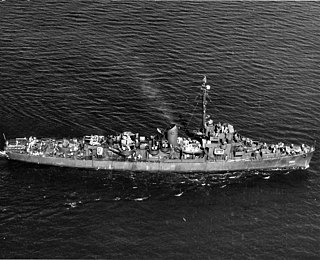
USS Wright (AZ-1/AV-1) was a one-of-a-kind auxiliary ship in the United States Navy, named for aviation pioneer Orville Wright. Originally built as a kite balloon tender, she was converted into a seaplane tender after kite balloons were no longer used.

USS Albemarle (AV-5) was one of only two Curtiss-class seaplane tenders built for the United States Navy just prior to the United States' entry into World War II. Named for Albemarle Sound on the North Carolina coast, she was the third U.S. Naval vessel to bear the name. Albemarle was laid down on 12 June 1939 at Camden, New Jersey, by the New York Shipbuilding Corporation, and launched on 13 July 1940, sponsored by Mrs. Beatrice C. Compton, the wife of the Honorable Lewis Compton, Assistant Secretary of the Navy. She was commissioned at the Philadelphia Navy Yard on 20 December 1940, with Commander Henry M. Mullinnix in command. She was transferred to the Maritime Administration (MARAD) James River Fleet at Fort Eustis, Virginia. Placed in the custodial care of MARAD, Albemarle was struck from the Naval Vessel Register on 1 September 1962.

The second USS Dixie (AD-14) was the first of her class of destroyer tenders built just before the start of World War II for the U.S. Navy. Her task was to service destroyers in, or near, battle areas and to keep them fit for duty.

USS Williamson (DD-244/AVP-15/AVD-2/APD-27) was a Clemson-class destroyer in the United States Navy during World War II. She was named for Commander William Price Williamson.

USS Hulbert (DD-342/AVD-6) was a Clemson-class destroyer in the United States Navy following World War I. She was named for Henry Hulbert.

USS William T. Powell (DE/DER-213), a Buckley-class destroyer escort of the United States Navy, was named in honor of Gunner's Mate William T. Powell (1918-1942), who was killed in action, aboard the heavy cruiser USS San Francisco off Guadalcanal on 12 November 1942.

USS Alexander J. Luke (DE/DER-577), a Buckley-class destroyer escort of the United States Navy, was named in honor of Sergeant Alexander J. Luke (1916–1942), who was killed in action during the attack on Tulagi on 6 August 1942. He was posthumously awarded the Silver Star.

USS Grand Canyon (AD-28) was a Shenandoah-class destroyer tender built at the tail end of World War II, and named for the Grand Canyon on the Colorado River.

USS Melville (AD-2) was a United States Navy destroyer tender that saw service in both World Wars. Laid down by the New York Shipbuilding Corporation of Camden, New Jersey, on 11 November 1913, she was launched on 2 March 1913, sponsored by Miss Helen W. Neel, granddaughter of Rear Admiral George W. Melville; and was first commissioned on 3 December 1915, Comdr. Henry Bertram Price in command.

The USS Altair (AD-11) was the lead ship of a class of three destroyer tenders. She was named for Altair, the brightest star in the constellation Aquila.

USS Hamul (AD-20) was the lead ship of a class of two destroyer tenders; she was most likely named after Hamal, the brightest star in the constellation Aries.

USS Denebola (AD-12) was an Altair-class destroyer tender named for Denebola, the second-brightest star in the constellation Leo.

USS Sandpiper (AM-51) was a Lapwing-class minesweeper. Laid down on 15 November 1918 at the Philadelphia Navy Yard, Philadelphia, Pennsylvania, and launched on 28 April 1919, USS Sandpiper was commissioned on 9 October 1919, redesignated AM-51 on 17 February 1920, and reclassified as a Small Seaplane Tender, AVP-9 on 22 January 1936.

USS Vulcan (AR-5) was the lead ship of her class of repair ships of the United States Navy. The ship was laid down on 16 December 1939 at Camden, New Jersey, by the New York Shipbuilding Corporation; launched on 14 December 1940; sponsored by Mrs. James Forrestal, wife of the Under Secretary of the Navy; and commissioned at the Philadelphia Navy Yard on 14 June 1941.

USS Wingfield (DE-194) was a Cannon-class destroyer escort built for the United States Navy during World War II. She served in the Atlantic Ocean and Pacific Ocean and provided escort service against submarine and air attack for Navy vessels and convoys.

USS Moore (DE-240) was an Edsall-class destroyer escort built for the U.S. Navy during World War II. She served in the Atlantic Ocean the Pacific Ocean and provided destroyer escort protection against submarine and air attack for Navy vessels and convoys.

USS Rhodes (DE-384) was an Edsall-class destroyer escort in service with the United States Navy from 1944 to 1946 and from 1955 to 1963. She was scrapped in 1975.

USS Sierra (AD-18) was a Dixie-class destroyer tender built just before the start of World War II for the U.S. Navy. Her task was to service destroyers in, or near, battle areas and to keep them fit for duty.

USS Yosemite (AD-19) was a Dixie-class destroyer tender built during World War II for the U.S. Navy. Her task was to service destroyers in, or near, battle areas and to keep them fit for duty.

The second USS Barnegat (AVP-10), in commission from 1941 to 1946, was the lead ship of her class of small seaplane tenders built for the United States Navy just before and during World War II. She was the second U.S. Navy ship to bear that name.




















